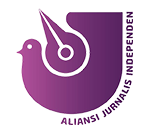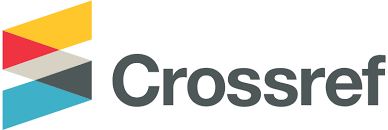The Antagonist Visual Framing of Soekarno in Kompas Daily‘s 1966 Photo Selection
Abstract
This paper examined Kompas Daily’s editorial framing strategy in depicting President Soekarno as an antagonist during Indonesia’s 1966 political turbulence. It investigated how the newspaper used visual framing, photo selection, and headline composition to construct contrasting images of Soekarno and his successor, Soeharto. Employing a qualitative method with visual and contextual analysis, this research analyzed the symbolic representation of leadership transition in Kompas’s front-page layout published on February 23, 1967. The findings revealed that Kompas framed Soekarno as a declining and melancholic figure while Soeharto was presented as confident and resolute. These visual choices were not neutral but tendentious in shifting political power, allowing Kompas to adapt to the rise of the New Order regime. The study introduces the concept of “swinging journalism” to describe the maneuver of media institutions to survive during the changing political climates. This framing positioned Kompas as not only a chronicler of events but also an agent that legitimized the New Order through subtle visual rhetoric. The paper suggested that visual media could shape public memory and political legitimacy during transitional periods. Therefore, it contributes to the growing body of literature on media representation, newsroom dynamics, and the visual construction of political narratives in authoritarian contexts. Furthermore, this study presents a case-specific illustration of editorial decision-making and ideological positioning in Indonesia’s press history, and contributes conceptual perspectives relevant to broader media studies.
Keywords
Full Text:
PDFReferences
Adiprasetio, J. (2025). Genealogy of Indonesian developmental journalism: The Pancasila press during authoritarian new order (1966–1998). Media History, 1–20. https://doi.org/10.1080/13688804.2025.2502615
Ahmad, N. (2022). The four faces of authoritarian populism and their consequences on journalistic freedom: A lesson learnt from Indonesia’s 2019 presidential election. TRaNS: Trans -Regional and -National Studies of Southeast Asia, 10(2), 189–201. https://doi.org/10.1017/trn.2021.16
Åker, P. (2025). Photography and reality. Reflections around the role of the photographer among photo students in Russia and Sweden. Visual Studies, 1–12. https://doi.org/10.1080/1472586X.2025.2510318
Akihary, S., Marta, R. F., & Panggabean, H. (2023). Media framing of identity politics through prejudice and stereotype towards the 2024 election. Kajian Jurnalisme, 7(1), 14–26. https://doi.org/10.24198/jkj.v7i1.46191
Aviandy, M., Budiman, M., & Hapsarani, D. (2024). Framing glasnost and perestroika, criticising the new order: An analysis of Kompas’ news coverage. Cogent Arts & Humanities, 11(1). https://doi.org/10.1080/23311983.2024.2303186
Azqandi, H. A., Fahimifar, A., & Sheikhmehdi, A. (2020). From commitment to expressionism: A survey on the changing concept of photography in Iran. Visual Studies, 37(5), 569–580. https://doi.org/10.1080/1472586X.2020.1822205
Besman, A., Hidayat, D. R., Bajari, A., & Moosmüller, A. (2023). Communism issues in Kompas Daily, transformation from the old order to the new order era. Journal of Hunan University Natural Sciences, 50(1), 101–114. https://doi.org/10.55463/issn.1674-2974.50.1.11
Blumell, L. E., & Mulupi, D. (2024). How news organizations cultivate and maintain sexist newsrooms via gendered journalistic norms, sexual harassment, and the boys’ club. Women’s Studies in Communication, 47(3), 268–291. https://doi.org/07491409.2024.2342842
Bucy, E. P., & Joo, J. (2020). Editors’ introduction: Visual politics, grand collaborative programs, and the opportunity to think big. The International Journal of Press/Politics, 26(1), 5–21. https://doi.org/10.1177/1940161220970
Busch, B. (2021). The body image: Taking an evaluative stance towards semiotic resources. International Journal of Multilingualism, 18(2), 190–205. https://doi.org/10.1080/14790718.2021.1898618
Colpani, G. (2021). Two theories of hegemony: Stuart Hall and Ernesto Laclau in conversation. Political Theory, 50(2), 221–246. https://doi.org/10.1177/00905917211019392
Cools, H., Gorp, B. Van, & Opgenhaffen, M. (2022). Where exactly between utopia and dystopia? A framing analysis of ai and automation in US newspapers. Journalism, 25(1), 3–21. https://doi.org/10.1177/14648849221122647
Crawford, O. (2022). The communist manifesto in Indonesia. Journal of Southeast Asian Studies, 53(3), 562–582. https://doi.org/10.1017/S0022463422000583
Croissant, A. (2022). Indonesia: Challenges of conflict and consensus in the era of reformasi. In Comparative Politics of Southeast Asia (pp. 75–119). Springer. https://doi.org/10.1007/978-3-031-05114-2_4
Dhakidae, D. (1991). The rise of capital and the fall of political journalism: Political economy of indonesian news industry. Cornell University.
Dhanesh, G. S., & Rahman, N. (2021). Visual communication and public relations: visual frame building strategies in war and conflict stories. Public Relations Review, 47(1), 102003. https://doi.org/10.1016/j.pubrev.2020.102003
Dodds, T., Vreese, C. de, Helberger, N., Resendez, V., & Seipp, T. (2023). Popularity-driven metrics: Audience analytics and shifting opinion power to digital platforms. Journalism Studies, 24(3), 403–421. https://doi.org/10.1080/1461670X.2023.2167104
Eddyono, S. (2023). The shift in the regime of silence: Selective erasure of the 1965 massacre in post-new order Indonesia’s official narrative. Memory Studies, 17(4), 776–794. https://doi.org/10.1177/17506980231155565
Elsheikh, D., Jackson, D., & Jebril, N. (2024). Revisiting the hierarchy of influences on journalism in a transitional context: When the social system level prevails. International Journal of Communication, 18, 3347–3365. https://ijoc.org/index.php/ijoc/article/view/21422
Fadillah, R. S., Abdullah, A., & Besman, A. (2022). Adaptation of convergence by local media Pikiran Rakyat and AyoBandung.Com. Kajian Jurnalisme, 6(1), 45–63. https://doi.org/10.24198/jkj.v6i1.39193
Grabe, M. E., & Bucy, E. P. (2014). Image bite analysis of political visuals: Understanding the visual framing process in election news. In Sourcebook for Political Communication Research. Routledge.
Grange, H., & Lian, O. S. (2022). Doors started to appear:’ A methodological framework for analyzing visuo-verbal data drawing on roland barthes’s classification of text-image relations. International Journal of Qualitative Methods, 21. https://doi.org/10.1177/16094069221084433
Greguš, Ľ., Predmerská, A. K., & Radošinská, J. (2022). Misleading through images: Television news as simulacrum. Studies in Media and Communication, 10(2), 65–80. https://doi.org/10.11114/smc.v10i2.5557
Hamada, B. I., Abdel-Salam, A.-S. G., & Bebawi, S. (2024). Journalism practices in western and muslim majority countries: Culture matters. The International Journal of Press/Politics, 0(0). https://doi.org/10.1177/19401612241260730
Hayase, S. (2020). The political changes of Indonesia (1965-1966) as reported by the manila times: Its impact on Southeast Asia as a region. Asian Studies: Journal of Critical Perspectives on Asia, 56(2), 120–149.
Johnson, P. L. (2025). Criminal communication: Public representations, repertoires, and regimes of criminal governance. Perspectives on Politics, 1–17. https://doi.org/10.1017/S1537592724001956
Kaufman, S. B., & Feingold, J. (2022). NChoose growth: A workbook for transcending trauma, fear, and self-doubt. Penguin.
Koch, T., Viererbl, B., & Schulz-Knappe, C. (2021). How much journalism is in brand journalism? How brand journalists perceive their roles and blur the boundaries between journalism and strategic communication. Journalism, 24(4), 749–766. https://doi.org/10.1177/14648849211029802
Kompas Daily. (1967). Proses terdjadinja penjerahan kekuasaan pemerintahan pada Djenderal Soeharto. Harian Kompas.
Kontos, I., & Galanopoulos-Papavasileiou, I. (2024). Photojournalism: Values and constraints, aestheticism, and aftermath photography. European Journal of Fine and Visual Arts, 2(1), 1–11. https://doi.org/10.24018/ejart.2024.2.1.20
Kramp, L., Carpentier, N., Hepp, A., Kilborn, R., Kunelius, R., Nieminen, H., Olsson, T., TOSONI, S., Trivundza, I. T., Pruulmann-Vengerfeldt, P., Trivundza, I. T., & Tosoni, S. (2016). Politics, civil society and participation: media and communications in a transforming environment (Lumière). Bremen. http://www.researchingcommunication.eu/SuSo15-book-final.pdf
Krishnani, D., Shivakumara, P., Lu, T., Pal, U., Lopresti, D., & Kumar, G. H. (2021). A new context-based feature for classification of emotions in photographs. Multimedia Tools and Applications, 80, 15589–15618. https://doi.org/10.1007/s11042-020-10404-8
Krüger, J. M., Koch, M., & Bodemer, D. (2024). The role of context and interaction when learning with augmented 360° photos. In Communications in Computer and Information Science (Vol. 1904, pp. 3–21). Springer. https://doi.org/10.1007/978-3-031-47328-9_1
Künkler, M. (2024). Mobilization and arenas of opposition in Indonesia’s new order (1966–1998). American Behavioral Scientist, 69(7), 902–920. https://doi.org/10.1177/0002764223119580
Laghmam, M. Z. (2024). Documentary film and the politics of representation. The International Journal of Cross-Cultural Communication and Media Studies, 1(2), 10–20. https://doi.org/10.34874/PRSM.cms-vol1iss2.1093
Lev, D. (2021). Legal evolution and political authority in Indonesia: Selected essays. Kluwer Lauw International.
Lundin, R. B. (2025). Emotions and subjectivity in Swedish photojournalistic practices. Journalism Practice, 1–18. https://doi.org/10.1080/17512786.2025.2487918
Mellado, C., & Hermida, A. (2021). A conceptual framework for journalistic identity on social media: How the personal and professional contribute to power and profit. Digital Journalism, 10(2), 284–299. https://doi.org/10.1080/21670811.2021.1907203
Morgan, D. (2021). The lure of the image: Rpistemic fantasies of the moving camera. University of California Press.
Mustapa, H., & Hamid, I. (2024). Nasakom dilemma and the politics of Islamic organizations: NU and Muhammadiyah organizational politics during the guided democracy period [1959-1966]. Politea: Jurnal Politik Islam, 7(1), 1–33. https://doi.org/10.20414/politea.v7i1.9780
Nyman, T. J., Korkman, J., Lampinen, J. M., Antfolk, J., & Santtila, P. (2023). The masked villain: The effects of facial masking, distance, lighting, and eyewitness age on eyewitness identification accuracy. Psychology, Crime & Law, 31(3), 332–337. https://doi.org/10.1080/1068316X.2023.2242999
Osman, S. K. (2023). Propaganda surat khabar Harian Rakjat semasa konfrontasi Indonesia-Malaysia, 1963–1965 (Propaganda of Harian Rakjat newspaper during the Indonesia-Malaysia confrontation, 1963-1965). Applied History Journal of Merong Mahawangsa, 1(1), 26–53. https://doi.org/10.32890/ahjmm2023.1.3
Palguna, I. D., & Bisariyadi. (2024). Indonesia’s diversity: A brief constitutional perspective. In Courts and Diversity (pp. 17–54). Brill. https://doi.org/10.1163/9789004691698_003
Pech, G. P., & Caspar, E. A. (2023). Does the cowl make the monk? The effect of military and red cross uniforms on empathy for pain, sense of agency and moral behaviors. Frontiers in Psychology, 14, 1255835. https://doi.org/10.3389/fpsyg.2023.1255835
Porlezza, C. (2023). Promoting Responsible AI: A European perspective on the governance of artificial intelligence in media and journalism. Communications, 48(3), 70–94. https://doi.org/10.1515/commun-2022-0091
Prayogi, A., Nasrullah, R., & Mutaqin, B. K. (2024). Democracy during the old order: A study of historical characteristics. Journal of Humanities Research Sustainability, 1(2), 75–83. https://doi.org/10.70177/jhrs.v1i2.1178
Putri, S. A. (2024). The politics of representation of the G 30 S incident at the Museum of Monumen Pahlawan Pancasila. Journal of Philology and Historical Review, 2(1), 44–61. https://doi.org/10.61540/jphr.v2i1.72
Reese, S. D. (2021). The institution of journalism: Conceptualizing the press in a hybrid media system. Digital Journalism, 10(2), 253–266. https://doi.org/10.1080/21670811.2021.1977669
Rose, G. (2016). Visual methodologies: An introduction to researching with visual materials (4th ed.). SAGE Publications.
Saputra, S. J. (2021). Kekuatan visual dalam mendisiplinkan khalayak di masa pandemi Covid-19. Kajian Jurnalisme, 4(2), 120–133. https://doi.org/10.24198/jkj.v4i2.27811
Shadaydeh, M., Müller, L., Schneide, D., Thümmel, M., Kessler, T., & Denzler, J. (2021). Analyzing the direction of emotional influence in nonverbal dyadic communication: A facial-expression study. IEEE Access, 9, 73780–73790. https://doi.org/10.1109/ACCESS.2021.3078195
Sitompul, Q. A. A.-Z., & Nasution, K. (2025). Roland Barthes’ semiotic analysis on Jamal Ramadhan’s photojournalistic works about the arrest of the minister of agriculture. International Journal of Cultural and Social Science, 6(2), 498–505. https://doi.org/10.53806/ijcss.v6i2.1021
Smellie, S., & Boswell, C. (2025). The influence of media narratives on political debate: Narratives on the 2015 migrant ‘crisis’ in five european countries. Journal of Ethnic and Migration Studies, 1–20. https://doi.org/10.1080/1369183X.2025.2523113
Taylor, D., & Yapp, M. (2024). Political identity in South Asia. Routledge. https://doi.org/10.4324/9781032715575
Wijayanto, & Masduki. (2023). Polite Watchdog’: Kompas and Watchdog journalism in post-authoritarian Indonesia. The International Journal of Press/Politics, 29(3), 628–645. https://doi.org/10.1177/19401612231196
Xu, Y., Yu, J., & Löffelholz, M. (2022). Portraying the pandemic: Analysis of textual-visual frames in German news coverage of Covid-19 on Twitter. Journalism Practice, 18(4), 858–878. https://doi.org/10.1080/17512786.2022.2058063
Zustiyantoro, D., Ali, A. H., & Amali, Z. (2023). Social cognition in Kompas daily editorials. Abjad Journal of Humanities & Education, 1(2), 121–129. https://doi.org/10.62079/abjad.v1i2.29
DOI: https://doi.org/10.24198/jkj.v9i1.53730
Refbacks
- There are currently no refbacks.
Copyright (c) 2025 The Author(s)

This work is licensed under a Creative Commons Attribution-NonCommercial-ShareAlike 4.0 International License.
Kajian Jurnalisme Indexed by:
Editorial Office of Kajian Jurnalisme:
Journalism Study Program, Faculty of Communication Sciences, Universitas Padjadjaran
Building 3 2nd Floor, Jl. Raya Bandung Sumedang KM.21, Jatinangor, Sumedang Regency, West Java 45363
Email: kajian.jurnalisme.fikom@unpad.ac.id
Telepon: (022) 7796954
Faks: (022) 7794122
Kajian Jurnalisme Supervised by:













